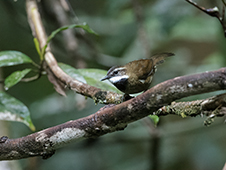
The Red List Index (RLI) measures trends in extinction risk over time (illustrating its inverse: survival probability). The RLI for birds has shown a steady decline over the last three decades, indicating an overall increase in extinction risk. Since 1988, 93 species have been downlisted to a lower Red List category due to a genuine improvement in status, but this is outweighed by the 436 species that moved to a higher category of threat because of a genuine deterioration in their status. Estimates based on these trends predict an overall effective extinction rate (the average probability of extinction per species per year) of 2.17 x 10-4/species/year – six times higher than the rate of outright extinction since 1500.

The Red List Index (RLI) was developed by BirdLife as an indicator of trends in the status of biodiversity, and is now used by the world’s governments and the United Nations. The index is based on the number of species in each category of the IUCN Red List and the number that moved between categories as a result of genuine changes in status (i.e. excluding moves resulting from improved knowledge or taxonomic changes) (Butchart et al. 2004, 2005, 2007). The RLI shows changes in the overall status (extinction risk) of groups of species, with RLI values relating to the proportion of species expected to remain extant in the near future without additional conservation action.
The Red List Index for birds shows that there has been a steady and continuing deterioration in the status of the world’s birds between 1988 (when the first comprehensive global assessment was carried out by BirdLife International; Collar and Andrew 1988) and 2020 (BirdLife International 2022). Since 1988, 93 species have been downlisted to a lower Red List category due to a genuine improvement in status, but this is outweighed by the 436 species that moved to a higher category of threat because of a genuine deterioration in their status. The overall effective extinction rate (the average probability of extinction per species per year) is estimated to be 2.17 x 10-4/species/year – six times higher than the rate of outright extinction since 1500 (Monroe et al. 2019).
Links
References
BirdLife International (2022) IUCN Red List of Threatened Species. Cambridge: UK: BirdLife International.
Butchart, S. H. M., Stattersfield, A. J., Bennun, L. A., Shutes, S. M., Akçakaya, H. R., Baillie, J. E. M., Stuart, S. N., Hilton-Taylor, C. and Mace, G. M. (2004) Measuring global trends in the status of biodiversity: Red List Indices for birds. Public Lib. Sci. Biol. 2: 2294–2304.
Butchart, S. H. M., Stattersfield, A. J., Bennun, L. A., Akçakaya, H. R., Baillie, J. E. M., Stuart, S. N., Hilton-Taylor, C. and Mace, G. M. (2005) Using Red List Indices to measure progress towards the 2010 target and beyond. Phil. Trans. Roy. Soc. 1454: 255–268.
Butchart, S. H. M., Akçakaya, H. R., Chanson,J., Baillie, J. E. M., Collen, B., Quader, S., Turner, W. R., Amin, R., Stuart, S. N.,Hilton-Taylor, C. and Mace, G. M. (2007) Improvements to the Red List Index. Public Lib. Sci. One 2(1): e140. doi:10.1371/journal.pone.0000140
Collar, N. J. and Andrew, P. (1988) Birds to watch: the ICBP world checklist of threatened birds. Cambridge, UK: International Council for Bird Preservation and International Union for Conservation of Nature and Natural Resources.
Monroe, M. J., Butchart, S. H. M., Mooers, A. O. & Bokma, F. (2019) The dynamics underlying avian extinction trajectories forecast a wave of extinctions. Biol. Lett. 15(12): 20190633
Compiled: 2004 Last updated: 2022
Recommended Citation:
BirdLife International (2022)
The status of the world's birds has deteriorated in recent decades.
Downloaded from https://datazone.birdlife.org/sowb/casestudy/the-status-of-the-worlds-birds-has-deteriorated-in-recent-decades on 22/12/2024